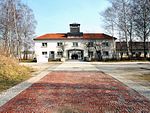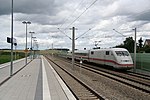Dachau liberation reprisals

During the Dachau liberation reprisals, German SS troops were killed by U.S. soldiers and concentration camp internees at the Dachau concentration camp on April 29, 1945, during World War II. It is unclear how many SS men were killed in the incident, but most estimates place the number killed at around 35–50. In the days before the camp's liberation, SS guards at the camp had forced 7,000 inmates on a death march that resulted in the death of many from exposure and shooting. When Allied soldiers liberated Dachau, they were variously shocked, horrified, disturbed, and angered at finding the massed corpses of internees, and by the combativeness of some of the remaining guards who allegedly fired on them.
Excerpt from the Wikipedia article Dachau liberation reprisals (License: CC BY-SA 3.0, Authors, Images).Dachau liberation reprisals
Geographical coordinates (GPS) Address Nearby Places Show on map
Geographical coordinates (GPS)
| Latitude | Longitude |
|---|---|
| N 48.272055555556 ° | E 11.458305555556 ° |
Address
85221
Bavaria, Germany
Open on Google Maps











